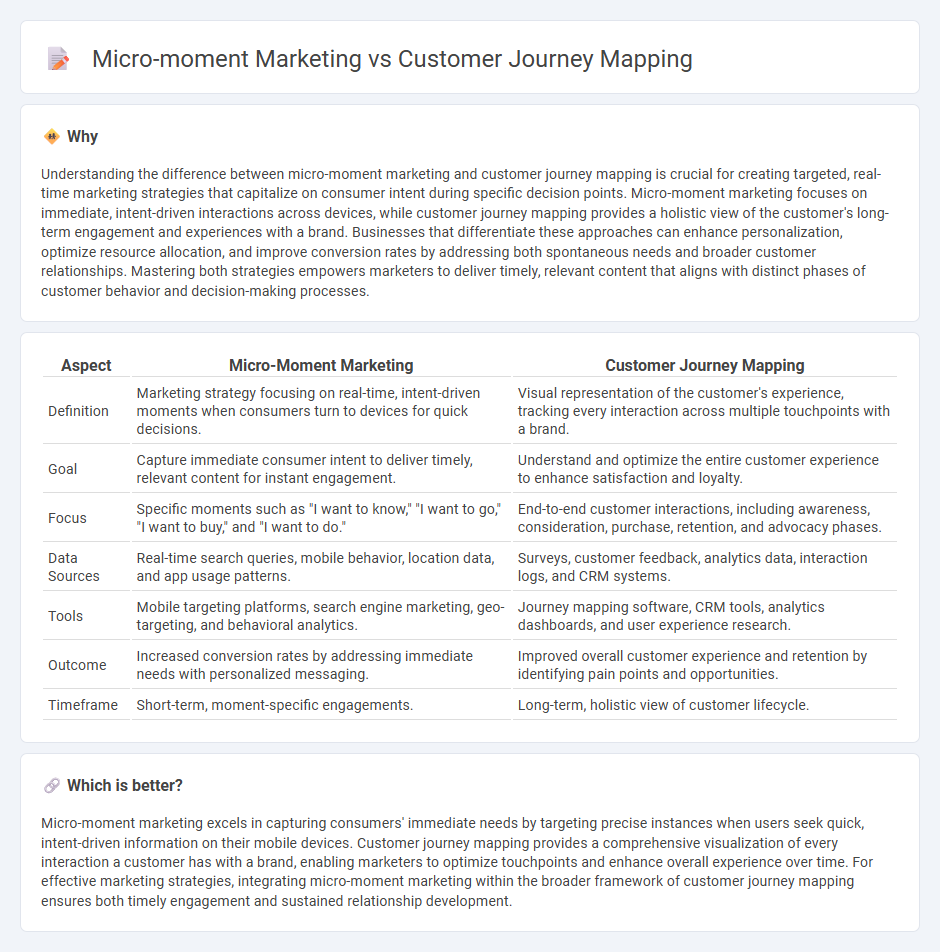
Micro-moment marketing targets specific, intent-driven moments when consumers turn to their devices for immediate answers, emphasizing real-time engagement and contextually relevant content. Customer journey mapping provides a comprehensive framework to visualize and analyze the entire sequence of interactions a customer experiences with a brand, identifying touchpoints and pain points across channels. Explore how integrating micro-moment marketing with customer journey mapping can optimize your marketing strategy for enhanced customer satisfaction and conversion rates.
Why it is important
Understanding the difference between micro-moment marketing and customer journey mapping is crucial for creating targeted, real-time marketing strategies that capitalize on consumer intent during specific decision points. Micro-moment marketing focuses on immediate, intent-driven interactions across devices, while customer journey mapping provides a holistic view of the customer's long-term engagement and experiences with a brand. Businesses that differentiate these approaches can enhance personalization, optimize resource allocation, and improve conversion rates by addressing both spontaneous needs and broader customer relationships. Mastering both strategies empowers marketers to deliver timely, relevant content that aligns with distinct phases of customer behavior and decision-making processes.
Comparison Table
| Aspect | Micro-Moment Marketing | Customer Journey Mapping |
|---|---|---|
| Definition | Marketing strategy focusing on real-time, intent-driven moments when consumers turn to devices for quick decisions. | Visual representation of the customer's experience, tracking every interaction across multiple touchpoints with a brand. |
| Goal | Capture immediate consumer intent to deliver timely, relevant content for instant engagement. | Understand and optimize the entire customer experience to enhance satisfaction and loyalty. |
| Focus | Specific moments such as "I want to know," "I want to go," "I want to buy," and "I want to do." | End-to-end customer interactions, including awareness, consideration, purchase, retention, and advocacy phases. |
| Data Sources | Real-time search queries, mobile behavior, location data, and app usage patterns. | Surveys, customer feedback, analytics data, interaction logs, and CRM systems. |
| Tools | Mobile targeting platforms, search engine marketing, geo-targeting, and behavioral analytics. | Journey mapping software, CRM tools, analytics dashboards, and user experience research. |
| Outcome | Increased conversion rates by addressing immediate needs with personalized messaging. | Improved overall customer experience and retention by identifying pain points and opportunities. |
| Timeframe | Short-term, moment-specific engagements. | Long-term, holistic view of customer lifecycle. |
Which is better?
Micro-moment marketing excels in capturing consumers' immediate needs by targeting precise instances when users seek quick, intent-driven information on their mobile devices. Customer journey mapping provides a comprehensive visualization of every interaction a customer has with a brand, enabling marketers to optimize touchpoints and enhance overall experience over time. For effective marketing strategies, integrating micro-moment marketing within the broader framework of customer journey mapping ensures both timely engagement and sustained relationship development.
Connection
Micro-moment marketing leverages real-time consumer intent to deliver targeted content at precise points within the customer journey. Customer journey mapping identifies these critical touchpoints, allowing marketers to optimize interactions based on consumer behavior and preferences. Integrating both strategies enhances personalized marketing efforts, increasing engagement and conversion rates.
Key Terms
**Customer Journey Mapping:**
Customer Journey Mapping visually represents each touchpoint a customer interacts with throughout their path to purchase, enabling businesses to identify pain points and optimize the overall experience. This strategic tool provides in-depth insights into customer behaviors and motivations across various channels, enhancing targeted marketing efforts and increasing conversion rates. Explore how Customer Journey Mapping can transform your marketing strategy and drive customer satisfaction.
Touchpoints
Customer journey mapping identifies key touchpoints across the entire buying process, providing a comprehensive view of customer interactions from awareness to post-purchase. Micro-moment marketing targets specific, intent-rich touchpoints where consumers quickly seek information or take action, emphasizing real-time engagement. Explore how mastering both strategies can enhance personalized customer experiences and boost conversion rates.
Persona
Customer journey mapping breaks down consumer interactions into stages, providing a comprehensive view of persona behaviors and preferences across their decision-making process. Micro-moment marketing targets specific, intent-driven moments when customers seek quick solutions or information, aligning content with immediate needs of distinct personas. Explore how combining both strategies enhances personalized marketing effectiveness and customer engagement.
Source and External Links
The customer journey map and why it's important - A customer journey map is a visual representation of the contact points between a customer and a company throughout their relationship, created by setting goals, defining customer personas, and identifying touchpoints across the buying process to uncover insights and improve experiences.
What is a Customer Journey Map? - It is a visual representation of every customer experience with a brand, spanning key stages from awareness to postpurchase, incorporating personas, touchpoints, emotions, pain points, and validation with real customers.
30 Best Customer Journey Mapping Tools of 2025 - Customer journey maps can be created using various tools and methods such as web analytics, customer feedback, and visual mapping techniques to track discovery, purchase, usage, and retention phases, while avoiding reliance on unverified data.
 dowidth.com
dowidth.com